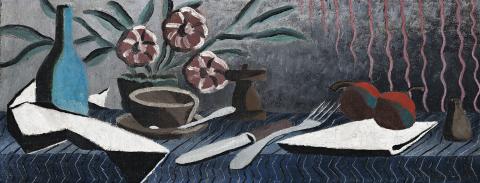STILL LIFE, 1937
PETER PURVES SMITH
oil on hessian
22.0 x 55.0 cm
inscribed verso: ORRONG RD.
Maisie Drysdale, New South Wales
Niagara Galleries, Melbourne
Private collection, Melbourne, acquired from the above in 2000
Homage to Peter Purves Smith, Joseph Brown Gallery, Melbourne, 12 – 28 July 1976, cat. 14 (illus. in exhibition catalogue, unpaginated)
The year 1937 was significant for Peter Purves Smith both in his personal life and career as an artist. It was the year he returned to Melbourne after touring Europe for two years and studying under Iain Macnab at the Grosvenor School in London and continued his pursuit of an artistic career enrolling at the George Bell School. Here he forged a long-lasting friendship with fellow artist Russell Drysdale, and his then future wife Maisie Newbold (later to become Drysdale’s wife). It was a year where both artists produced remarkably competent still life and figure compositions with a vision beyond the formal direction of George Bell. Both artists were inspired by contemporary French painting. In Purves Smith’s case, the earlier painting New York 1936 (collection, the Art Gallery of New South Wales) and works that followed in the late 1930s, owed much to the organic imagery of the Surrealists, having viewed the International Surrealist Exhibition in London mid 1936. Drysdale on the other hand, was strongly influenced by the School of Paris, in particular Modigliani and Moise Kisling – his early masterpiece The Rabbiter and His family 1938 (collection, National Gallery of Australia, Canberra) made while studying at the George Bell School, owes much to the School of Paris.
Still Life, 1937 was first exhibited in Homage to Peter Purves Smith, a survey exhibition at the Joseph Brown Gallery in 1976 and was the only selected still life subject he created before returning to Europe in 1938. This painting in particular exhibits a starkness and intensity reminiscent of the Adelaide artist James Cant. In 1937 Cant exhibited in London with de Chirico, Max Ernst and Paul Klee. He experimented with the late cubist style of Georges Braque and Pablo Picasso and the surrealism of Giorgio de Chirico and René Magritte. Purves Smith too was as an artist continually searching and experimenting and open to modern British as well as French influences as displayed in Still Life 1937.
The distinctive and imaginative art of Purves Smith, produced during a shortened career (with his early death at the age of 37), combined his own folk qualities with Macnab and Bell’s more formalist grammar and embraced a quasi-Surrealism. He returned to Europe early 1938, as did Drysdale, well aware of the rising tensions on the edge of World War II. This had a profound effect on his art and subjects at this time.
